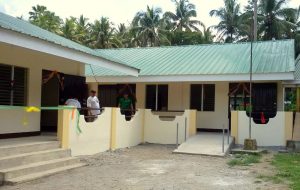
The said school buildings, worth PhP14.07 Million in total, are constructed in Brgys. Amot and Poblacion in Burdeos; Brgy. Madlangdungan in Calauag; Brgys. Arbismen and San Roque in Guinayangan; Brgy. Remedios I in Mauban; Brgy. Pinagtubigan Este in Perez, and; Brgy. Almasen in Unisan.
Further, there is a PhP784,495-worth day care center constructed in Brgy. Dungawan Central in Guinayangan.
The said classrooms are to benefit children from around 2,500 households in the said communities.
These are funded by the Department of Foreign Affairs and Trade (DFAT) of the Australian Government, one of the Kalahi-CIDSS’ development partners that builds school facilities in areas with significant gaps in education to provide better access to basic education services.
In a project turn-over ceremony in San Roque Elementary School in Guinayangan town last April, Teacher Isagani Arida shared how thankful he is for the new school building as they no longer need to hold multiple-grade classes in one classroom. He added that this could inspire children to study well and engage more in class activities.
Their school is provided with a three-classroom school building worth PhP2.27 Million, fully furnished with tables, chairs, shelves and other furniture and fixtures.
“Kami po ay taos-pusong nagpapasalamat dahil napakalaking bagay nito sa mga bata, maging sa mga magulang na nagnanais na mabigyan ng magandang edukasyon ang kanilang mga anak,” said Arida.
In the implementation of the said projects, the community-driven development strategy of Kalahi-CIDSS is applied wherein the local residents themselves are engaged in the local development process. They are organized as community volunteers who plan, implement and manage the operations and maintenance of the projects.
According to Annaliza Capule, the Municipal Monitor of Kalahi-CIDSS DFAT projects in the CALABARZON Region, the people are engaged in the process to encourage them to become active members of their communities.
“They look after their projects and keep track of every transaction to ensure that the funds and resources are used well. That’s why in this process, the success of the projects really depends on the participation of the people,” added Capule.
Regina Bautista, one of the community volunteers in Brgy. San Roque, shared that she appreciates such process as it made her realize that she can contribute something good for her community.
“Kahit maraming gawa at inaasikasong mga dokumento, naitaguyod at natapos pa rin namin ang proyekto dahil sa pagtutulungan naming mga volunteers. Hindi namin akalain na kaya pala naming magpatupad ng ganitong proyekto kaya talagang napakasarap sa pakiramdam,” said Bautista.
The Kalahi-CIDSS is a poverty reduction program of the DSWD that aims to improve the delivery of social services in poor communities by empowering the people to be involved in the development process of their communities.
This 2016, the program is implemented in 22 municipalities in Quezon Province with a total of 643 need-responsive community projects including farm-to-market roads, water systems, school buildings and health centers among others.#
